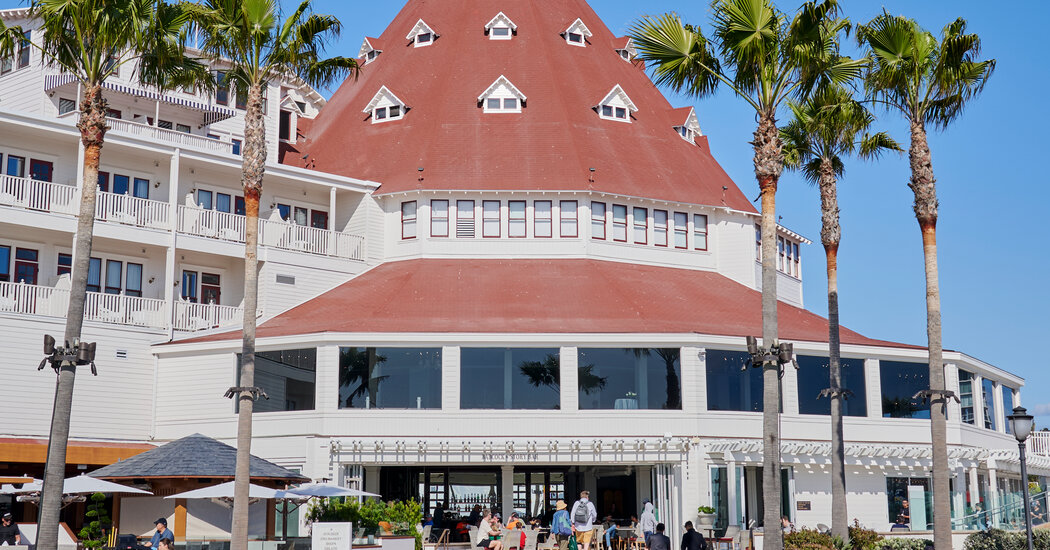To the people who know it, the Hotel del Coronado in San Diego is not a page of history — it’s a chapter. Opened in 1888 by Elisha Babcock and Hampton Story, it was then the largest hotel in the world. The owners set out to create a resort that would “be the talk of the Western world” — a 750-room Victorian right on the edge of the Pacific.
Charlie Chaplin, Judy Garland, Babe Ruth, Thomas Edison, Henry Ford — they all came to the Del, as it is known. “Some Like It Hot,” was shot at the hotel. Just up the coast from the hotel is the Naval Air Station North Island (as in “Top Gun”), and during World War II, the hotel housed naval officers for $2 a day. “The manager was worried they would lose money renting it so cheap but the officers more than made up for it in the bar,” said Gina Petrone, the hotel’s heritage manager.
Since 2019, the hotel has been undergoing the largest, most ambitious renovation in its history. Meticulously, deliberately — and very expensively — it has been restored to its former glory, and next month, after six years and $550 million, the renovation will be complete. (It is currently owned by the New York-based Blackstone Group.) Construction crews have been pulling out drywall, removing layers and layers of paint, tearing out dropped ceilings and peeling back decades of previous renovations so the Del can reclaim its original grandeur.
David Marshall, the president of Heritage Architecture & Planning, a San Diego-based firm specializing in historic renovation, oversaw the restoration project, with guidance from Ms. Petrone, using original photographs and the hotel’s first set of blueprints to inform as much of the renovation as possible. The elevator cage, the wood in the lobby, the railings on many of the balconies — all original. “We even kept the warping on some flooring,” he said, while standing on the undulating balcony overlooking the lobby. “We secured it so it’s structurally safe, but we wanted to keep that bit of history.” A bit of history that may make you feel drunk if you walk too fast.
Overlooking the lobby is the newly restored Coronation Window — a 700-piece, stained glass depiction of a woman, the unofficial patron saint of Coronado Island, crowning herself. “This window was from 1888 but it was moved several times so it’s even more incredible that it survived,” said Mr. Marshall. (Only a few panes had to be replaced.)
The real crown of the hotel is, well, the Crown Room. Imagine an airplane hangar made of Oregon sugar pine with ceilings 33 feet high and four massive crown-shaped chandeliers hanging down the center panels. (L. Frank Baum, a frequent guest who wrote “The Wonderful Wizard of Oz,” designed the signature chandeliers.) Walking into the Crown Room is like stepping onto the Titanic on dry land.
For the renovation, Mr. Marshall focused on the period from 1888 to 1948, when the hotel was mostly structurally unchanged.
“In the postwar era, people wanted things clean and smooth. They didn’t want ornate designs,” said Mr. Marshall. “They dropped the ceilings and covered anything that showed the hand of the craftsman. Everything was ‘form follows function.’ There was an architect at that time who actually said, ‘ornamentation is a crime.’”
Other changes over the decades were more practical. The hotel’s 750 guest rooms eventually became 371. “No two rooms are alike,” explained Mr. Marshall. “We couldn’t reuse a single drawing.”
“You have to remember that Victorians didn’t swim; they didn’t walk on the beach,” said Ms. Petrone. “Their swimsuits were made of wool. They came here for the sea air so the best rooms back then were the ones facing the garden.” In other words, the most desirable rooms today were the least popular in the late 1800s.
The National Historic Preservation Act of 1966 eventually put an end to the architectural heresy happening at the Del. And in 1977, it was designated a National Historic Landmark — putting it on par with the Statue of Liberty, Mount Rushmore and the Golden Gate Bridge.
But almost 50 years later, the architects had to figure out what was original, what was added later, and perhaps most importantly, what was hidden in the walls.
One afternoon during the renovation, Ms. Petrone called Mr. Marshall and told him to look at a spot in a second floor guest corridor. According to the blueprints, “there should be a window there,” Ms. Petrone told him. Sure enough, behind sheets of drywall, workers found original amber windows embedded in massive wooden panels.
Then a few months before the renovation was complete, Ms. Petrone was in the vestibule to the ballroom when she looked up. The ceiling was covered by construction equipment but there was something just behind the oil cloth. “I couldn’t believe it,” said Ms. Petrone. She had inadvertently discovered the building’s last remaining fresco — a burst of flowers — which has now been uncovered, restored, and marks the entrance to the hotel’s ballroom.
“People come to the Del to have a historical experience so preserving the integrity was very important,” said Mr. Marshall.
Apparently a “historical experience” can take many forms — like the presence of “Miss Kate.” In November 1892, a 27-year-old woman named Kate Morgan checked into the hotel alone under an assumed name. Five days later, she was found dead on the back patio, with a single gunshot wound to her head. But according to many people who stay at the Del, she never left.
“I get pictures every day from guests who have seen the ghost of Miss Kate,” said Ms. Petrone, laughing conspiratorially. “You know we do like to honor the past here.”
Follow New York Times Travel on Instagram and sign up for our Travel Dispatch newsletter to get expert tips on traveling smarter and inspiration for your next vacation. Dreaming up a future getaway or just armchair traveling? Check out our 52 Places to Go in 2025.




